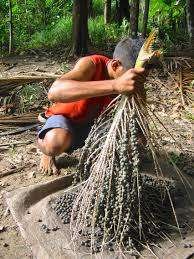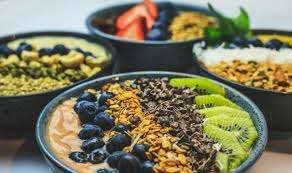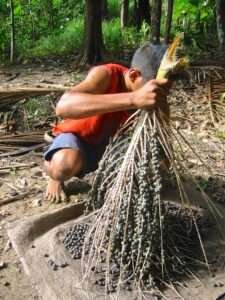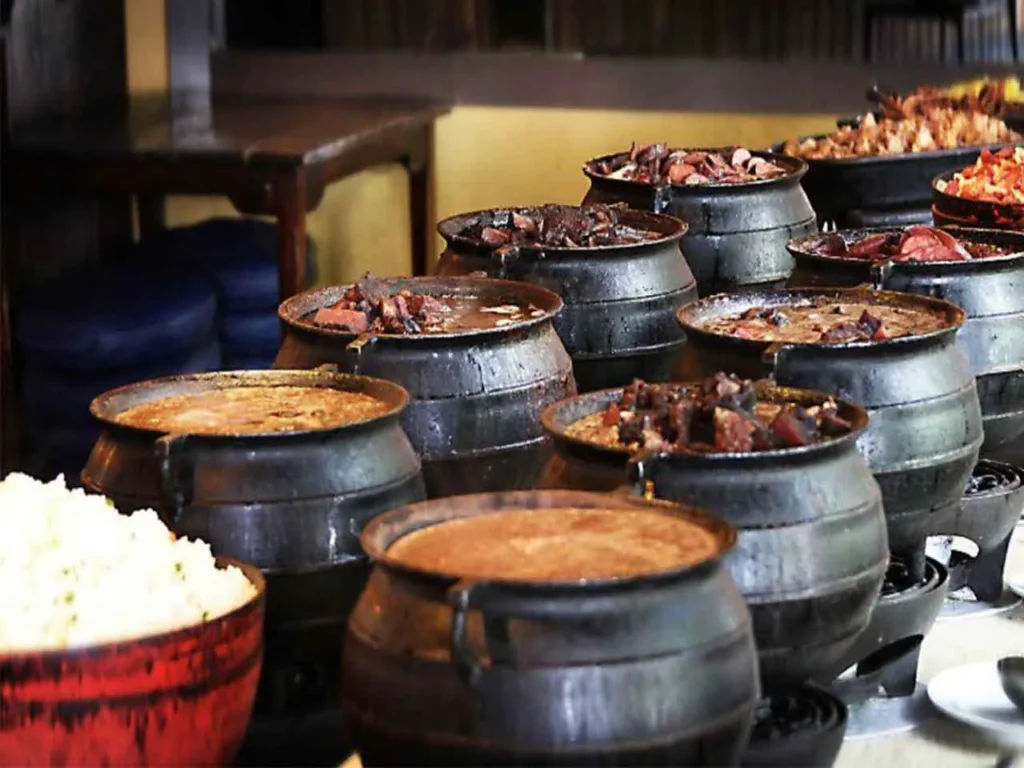
You’ve probably seen it. That vibrant, deep purple stuff swirled into a bowl, topped with granola, bananas, maybe a drizzle of honey. Or perhaps you’ve sipped it in a smoothie, feeling that cool, energizing rush. That, my friends, is açaí – a true superstar from the heart of the Amazon rainforest. But this little berry is so much more than just a pretty face in the world of health foods. It’s a story of nature, culture, and a journey from remote riverbanks to a spot on menus worldwide. As a chef, I appreciate ingredients with a story, and açaí’s tale is as rich as its flavor.

What Is Açaí? The Berry Behind the Buzz
So, what exactly is açaí? Pronounced “ah-sah-EE” (say it with me!), this powerhouse is a small, round, dark purple fruit, about an inch in diameter – roughly the size of a grape or a large blueberry. It grows in big clusters, kind of like bunches of grapes, on the majestic açaí palm tree, scientifically known as . These slender, multi-stemmed palms can soar to impressive heights, often reaching over 25 meters (that’s about 80 feet!) into the sky. Imagine these graceful trees swaying in the tropical breeze, their fronds like giant green feathers.
Now, here’s a surprise for many: that beautiful purple part we love? It’s mostly skin and a very thin layer of pulp clinging to a relatively large seed. Yep, the actual edible fruit flesh is only about 10-20% of the berry. This means it takes a lot of berries to produce the rich puree we’re familiar with. Despite this, the açaí berry has exploded onto the global scene, not just for its unique, slightly earthy, subtly sweet flavor (some say it’s a mix of wild berries and a hint of dark chocolate – what do you taste?), but also because it’s packed with antioxidants, particularly anthocyanins, which give it that signature deep purple color. It also boasts healthy fats (like those in olive oil) and fiber, making it a genuinely nutritious punch in a small package.
The açaí palm itself is a wonder. It’s not just a source of fruit. Traditionally, the palm hearts are eaten, the leaves are used for weaving baskets and mats, and the wood for construction in local communities. It’s a true gift of the forest.
The Heart of the Amazon: Where Açaí Grows Wild and Free
To really understand açaí, you need to picture where it comes from. We’re talking about the Amazon rainforest, the lungs of our planet, a place teeming with incredible biodiversity. Açaí palms are native to this magnificent, sprawling ecosystem, particularly thriving in the floodplains, swamps, and along the riverbanks of northern Brazil. The states of Pará, Amapá, and Amazonas are the undisputed champions of açaí production.

Pará, in particular, is the beating heart of the açaí world, accounting for a staggering 90% or more of Brazil’s entire output. Think of it as the Napa Valley for wine, but for açaí. The region’s consistently humid, tropical climate and its fertile, seasonally flooded lands create the perfect nursery for these palms. The trees love having their “feet wet,” so to speak, which is why the várzea (floodplain) forests are their ideal home.
In these parts of the Amazon, açaí isn’t just another fruit you pick from a tree; it’s deeply woven into the fabric of daily life and local culture. For the “ribeirinhos,” or river people – traditional communities whose lives are intimately connected to the Amazon’s waterways – harvesting açaí is a generational skill and a vital source of sustenance. These skilled climbers, often young men and boys, scale the tall, slender palm trunks with nothing but a looped strap around their feet (a peconha) or sometimes just their bare hands and feet. It’s a dangerous, physically demanding job, requiring incredible strength, balance, and courage as they navigate heights that would make most of us dizzy, all to bring down the precious bunches of purple gold.
Açaí in Brazilian Culture and Cuisine: More Than Just Sweet Bowls
If you travel to the Amazon, the way you see açaí consumed might surprise you. Forget the sweet, chilled bowls you find in trendy cafes. In its homeland, particularly in states like Pará and Amazonas, açaí is traditionally a staple food, often eaten as a savory, energy-boosting accompaniment to main meals.
Locals prepare what’s known as “vinho do açaí” (açaí wine – though it’s non-alcoholic) or “açaí grosso.” This is a thick, unsweetened açaí puree, made by soaking the berries in water to soften the pulp, then mashing and straining them to separate the skin and pulp from the large seed. The consistency is rich and creamy, almost like a thick gravy. This pure, unadulterated açaí is then typically served at room temperature or slightly warm in a bowl, alongside grilled or fried fish, shrimp, dried meat (charque or carne de sol), or chicken. A generous sprinkle of crunchy, toasted manioc flour (farinha de mandioca or farinha d’água) is almost mandatory, adding texture and soaking up the rich açaí. Imagine a comforting, hearty meal that fuels you for hours – that’s traditional Amazonian açaí.

This traditional way of eating açaí highlights its role as a fundamental source of calories and nutrients. For many families in the Amazon, açaí is on the table almost daily, much like rice or beans in other cultures. It’s a symbol of sustenance, community, and a deep connection to the forest. When families gather, sharing a large bowl of açaí is common, fostering a sense of togetherness. The cultural significance is profound; it’s celebrated in local festivals and even features in regional folklore and music. It’s a world away from the frozen, sweetened product that most of the globe knows, but understanding this heritage is key to appreciating the berry’s true identity.
From Local Staple to Global Superfood: The Açaí Boom
So how did this Amazonian staple burst onto the global health scene? Açaí’s journey from the remote rainforests to international cafés is a fascinating story of cultural exchange and clever marketing. While it’s been a food source for indigenous and river communities for centuries, its wider popularity within Brazil began to bubble up in the 1970s and 80s.
A key moment often credited for açaí’s rise was its adoption by athletes, particularly the Gracie family, the legendary founders of Brazilian Jiu-Jitsu (BJJ). Carlos Gracie Sr. was a pioneer in nutrition and natural health, and he recognized the energy-boosting and restorative properties of açaí. He and his family began promoting it as an ideal food for their fighters and students, helping them maintain stamina and recover from intense training. They started popularizing “açaí na tigela” (açaí in the bowl) – a sweetened, frozen version of the pulp, often blended with banana or other fruits and topped with granola. This made it more palatable to urban tastes outside the Amazon. (You can find Gracie Jiu-Jitsu academies worldwide, many with online presences, e.g.,
From the BJJ academies, açaí bowls quickly caught on with the vibrant surf culture of Rio de Janeiro in the 1990s. Beachgoers and fitness enthusiasts loved its refreshing taste and the sustained energy it provided. Small juice bars and beach kiosks started serving these frozen açaí bowls, and it became a trendy, healthy fast food. Its popularity soon spread to other major Brazilian cities like São Paulo.
The international leap happened in the late 1990s and early 2000s. Entrepreneurs, seeing the domestic craze and recognizing the berry’s nutritional profile, began to explore ways to export the delicate fruit, which spoils quickly after harvesting. The development of flash-freezing and pulp processing techniques was crucial. Companies started marketing açaí to health-conscious consumers in North America, Europe, and beyond, highlighting its antioxidant properties and exotic Amazonian origin. The “superfood” label stuck, and açaí became a must-have ingredient in smoothie bars, health food stores, and eventually, mainstream supermarkets worldwide. Today, you can find açaí in countless forms: frozen puree, powders, juices, supplements, and even in beauty products.
The Açaí Economy: A Lifeline for the Amazon and its People
The global hunger for açaí has transformed it into a significant economic engine for northern Brazil, particularly for the state of Pará. What was once primarily a local food source has become a valuable commodity, providing income and opportunities for tens of thousands of families.
The açaí supply chain is complex and involves many hands. It starts with the harvesters, the ribeirinhos, who brave the heights of the palms. Then there are the middlemen, or atravessadores, who buy the fruit from remote communities and transport it by boat – often the only way to navigate the intricate river systems – to processing plants in larger towns or cities. At these plants, the açaí is cleaned, depulped, pasteurized (in some cases), and typically frozen to preserve its nutrients and flavor for export or distribution to other parts of Brazil.

In Pará alone, it’s estimated that the açaí industry directly and indirectly employs around 30,000 people, and some estimates suggest the entire chain supports livelihoods for up to 200,000 people across the Amazon region. This economic activity is crucial in areas where other job opportunities can be scarce. The income from açaí helps families afford food, healthcare, and education for their children.
Importantly, a thriving açaí economy can also be a force for rainforest conservation. Because açaí palms are wild-harvested from existing forests, or cultivated in systems that mimic natural forest conditions (agroforestry), they provide a financial incentive to keep the trees standing. When local communities can earn a sustainable living from the forest, they become its most ardent protectors. It’s a prime example of a “standing forest” bio-economy, where the value lies in the intact ecosystem rather than in its destruction for cattle ranching, soy cultivation, or logging – major drivers of deforestation in the Amazon.
Sustainable Harvesting and Agroforestry: Keeping Açaí Green
With the booming demand for açaí, the question of sustainability is more critical than ever. The good news is that traditional açaí harvesting is inherently quite low-impact. The palms are not cut down; only the fruit clusters are carefully removed, allowing the tree to continue producing fruit year after year. A single açaí palm can have multiple stems, each producing fruit at different times, ensuring a continuous, albeit seasonal, supply.

Moreover, there’s a growing movement towards promoting and expanding agroforestry systems for açaí. Agroforestry is a land management approach that deliberately integrates trees and shrubs with crops or livestock. In the context of açaí, this means cultivating açaí palms alongside other valuable native species like Brazil nuts, cocoa, cupuaçu (another delicious Amazonian fruit), and various timber trees.
These integrated systems offer numerous benefits:
- Biodiversity Conservation: They create more complex habitats than monocultures, supporting a wider range of plants, insects, and animals.
- Soil Health: The mix of species helps maintain soil fertility and prevent erosion.
- Climate Resilience: Diverse systems are often more resilient to climate change impacts and pests.
- Diversified Income: Farmers aren’t reliant on a single crop, which buffers them against market fluctuations or crop failures.
Organizations like WWF-Brazil and various local cooperatives are actively working with communities to implement and scale up these sustainable agroforestry practices. They provide technical assistance, help with certification processes (like organic or Fair Trade), and connect producers to responsible buyers. This ensures that the açaí industry can continue to grow without compromising the ecological integrity of the Amazon or the well-being of its communities. The goal is to make sure that this purple gold truly benefits everyone, from the harvester to the consumer, and the forest itself.
Beyond the Bowl: Açaí’s Diverse and Emerging Uses
While the vibrant purple açaí bowl is its most famous ambassador, this versatile Amazonian fruit has a lot more to offer. The innovation doesn’t stop at frozen pulp and smoothies; researchers and entrepreneurs are continually exploring new ways to utilize different parts of the açaí berry and palm.

Açaí Oil in Cosmetics
The oil extracted from the açaí pulp (or sometimes the seed) is rich in antioxidants, essential fatty acids (like oleic acid and linoleic acid), and phytosterols. These components make it a prized ingredient in the cosmetics industry. Açaí oil is known for its moisturizing, anti-inflammatory, and anti-aging properties. You can find it in skin creams, lotions, hair care products, and lip balms, promising to nourish and protect the skin from environmental damage. This adds another stream of value to the açaí fruit.
Açaí Seeds – From Waste to Wonder
Remember that large seed that makes up most of the berry? For a long time, these seeds were largely considered a waste product of the pulping process, often discarded or used as simple organic fertilizer. However, that’s changing.
- Biofuel Potential: Researchers are investigating the potential of açaí seeds as a source for biofuel production. The seeds have a high lignocellulosic content, which can be converted into bioethanol or other energy forms.
- Biodegradable Materials: The seeds can be ground and incorporated into biodegradable plastics or composite materials, offering an eco-friendly alternative to petroleum-based plastics for things like packaging or even disposable cutlery.
- Animal Feed: Crushed or processed seeds are also being explored as a component in animal feed due to their fiber and nutrient content.
- Natural Exfoliant: Ground açaí seeds can be used as a natural exfoliant in soaps and body scrubs.
Traditional and Other Uses
Beyond food and new innovations, various parts of the açaí palm have long been used by Amazonian communities:
- Palm Heart: The heart of the palm (palmito) from some species of is a delicacy, though sustainable harvesting practices are crucial here.
- Leaves and Fibers: The durable leaves and fibers are traditionally used for thatching roofs, weaving baskets, hats, and other handicrafts.
- Wood: The trunk of the palm, though not a primary timber source, can be used for rustic construction.
These diverse applications highlight the full potential of the açaí palm, promoting a “whole-fruit” approach that minimizes waste and maximizes value. This not only benefits the economy but also strengthens the argument for preserving the ecosystems where these incredible trees thrive.
Challenges Ahead: Navigating Climate Change and Market Pressures
Despite the incredible success story of açaí, the industry isn’t without its hurdles. The very forces that have propelled its global fame also bring potential risks that need careful management to ensure a sustainable future for the berry and its Amazonian home.

Climate Change Impacts
The Amazon rainforest, while vast, is a delicately balanced ecosystem. Climate change poses significant threats:
- Altered Rainfall Patterns: Açaí palms depend on specific hydrological cycles, particularly seasonal flooding. Changes in rainfall intensity and frequency can disrupt these cycles, affecting fruit production and palm health. More intense droughts or prolonged floods can both be detrimental.
- Temperature Increases: Rising temperatures can stress the palms and potentially alter fruiting seasons or reduce yields.
- Increased Pest and Disease Pressure: Changing climatic conditions can lead to an increase in pests and diseases that affect açaí palms.
Market Pressures and Sustainability Concerns
The soaring global demand for açaí, while economically beneficial, can also create pressures:
- Overharvesting: In some easily accessible areas, there’s a risk of overharvesting if too much fruit is taken too frequently, potentially impacting the natural regeneration of açaí groves or the availability of fruit for local wildlife that also depends on it.
- Pressure for Monoculture: While wild-harvest and agroforestry are ideal, high demand could tempt some to clear forest for intensive açaí monocultures, which would reduce biodiversity and negate some of the conservation benefits.
- Social Equity: Ensuring that the economic benefits truly reach the local harvesters and communities is an ongoing challenge. Fair prices, safe working conditions, and community empowerment are crucial to avoid exploitation.
- Quality Control and Adulteration: As with any popular product, maintaining quality standards and preventing adulteration (e.g., excessive dilution or addition of other substances) is vital for consumer trust and the reputation of authentic Amazonian açaí.
Addressing these challenges requires a multi-pronged approach. This includes ongoing research into climate-resilient açaí varieties and sustainable management practices, strong government policies that support conservation and fair trade, active community involvement in resource management, and conscious consumer choices that favor ethically and sustainably sourced products.
NGOs and Companies Championing Açaí Sustainability: The Good Guys
Thankfully, many organizations and forward-thinking companies are deeply committed to ensuring that the açaí boom benefits the Amazon and its people in the long run. They are pioneering models of sustainable business that prioritize environmental stewardship and social responsibility.
Here are a few examples of the players making a positive difference:
Sambazon
One of the earliest and largest companies to bring açaí to the global market, Sambazon has built its entire business model around organic and Fair Trade certification. They partner directly with thousands of small family farmers and harvester communities in the Amazon. Their approach focuses on creating a “triple bottom line” – environmental sustainability, social equity (fair wages, community investments in healthcare and education), and economic prosperity. They’ve been instrumental in developing a market for certified sustainable açaí.
- What they do: Promote certified organic and Fair Trade açaí, invest in community projects, advocate for rainforest protection.
- Website: sambazon.com
- Instagram: @sambazon
WWF-Brazil (World Wildlife Fund)
This renowned international conservation organization has a strong presence in the Amazon. While not an açaí company itself, WWF-Brazil works extensively with local communities, government agencies, and businesses to promote sustainable resource management. This includes supporting the development and implementation of sustainable agroforestry systems for açaí and other non-timber forest products, helping to strengthen community-based enterprises, and advocating for policies that protect the rainforest.
- What they do: Support sustainable agroforestry, biodiversity conservation, community empowerment, and policy advocacy.
- Website: wwf.org.br
- Instagram: @wwfbrasil
Tribe Açaí
Companies like Tribe Açaí often emphasize direct sourcing, ensuring transparency in their supply chains, and committing to environmentally responsible practices. This might include supporting organic farming, minimizing their carbon footprint, and ensuring that harvesters receive fair compensation. They often market their açaí by telling the story of its origin and the positive impact of ethical sourcing.
- What they do (typically): Focus on environmentally responsible sourcing, direct trade relationships, and product purity.
- Website: tribeacai.com
- Instagram: @tribe_acai
Beyond these, many other local cooperatives, smaller brands, and research institutions are dedicated to the sustainable açaí movement. When you choose açaí from companies that are transparent about their sourcing and committed to third-party certifications (like Organic, Fair Trade, B Corp), you’re voting with your wallet for a healthier planet and fairer system for Amazonian communities.
Experiencing Authentic Açaí in Brazil: A Chef’s Tasting Tour
If you ever get the chance to travel to Brazil, especially to the Amazon region or even cities like Rio where açaí culture is strong, tasting it in its various authentic forms is a must-do culinary adventure. As a chef, I always seek out the real deal, and here’s what you should look for:
In the Amazon (Manaus, Belém, etc.):
Açaí do Pará (Manaus): Places like this are legendary for serving traditional, unsweetened açaí the way locals eat it. Expect a thick, deep purple, often slightly earthy puree served in a simple bowl (cuia). It will likely come with options like fried fish, shrimp, or charque (dried beef), and always with a side of farinha (manioc flour) – either d’água (coarser, fermented) or seca (finer, toasted). This is the true taste of Amazonian fuel.
- Find them: Search on platforms like Instagram or TripAdvisor for “Açaí do Pará Manaus” for latest locations and reviews. Example Instagram handles to look for:
Top Frozen Açaí (Manaus): While “frozen” is in the name, many places in the Amazon also offer fresh or minimally processed versions. This spot is known for quality and authentic flavors, likely catering to both traditional and slightly more modern palates. Ask for it “puro” or “natural” if you want to try it unsweetened.
In Rio de Janeiro:
Tacacá do Norte: This iconic spot in the Flamengo neighborhood of Rio is a true institution. They bring in pure, high-quality açaí directly from the North (Pará). While Rio is famous for sweet açaí bowls, here you can often get it less adulterated, or at least understand its northern roots. They are also famous for tacacá, an Amazonian soup, so you can have a full regional experience.
Beach Kiosks and Juice Bars (“Lanchonetes” or “Casas de Suco”): All along the beaches of Copacabana and Ipanema, and throughout the city, you’ll find countless places serving “açaí na tigela.” This is the classic sweetened, frozen version, often blended with banana or strawberry for creaminess and sweetness, and then generously topped with granola, sliced fruits (banana is standard), and sometimes honey or condensed milk (leite condensado) for an extra sweet kick. It’s refreshing, delicious, and a quintessential Rio experience.
Chef’s Tips for an Authentic Açaí Experience:
- Color is Key: Real, high-quality açaí is a very deep, dark purple, almost black. If it looks bright pink or overly light, it might be heavily diluted or mixed with too many other fruits.
- Ask for “Puro” or “Sem Xarope”: If you want to try it without added sugar syrup (xarope de guaraná is common), ask for “açaí puro” (pure açaí) or “sem xarope” (without syrup). It might still be naturally sweetened with fruit, but you’ll get closer to the true flavor.
- Embrace the Farinha: If you’re having traditional Amazonian açaí, don’t skip the manioc flour! It’s an essential part of the experience, adding texture and balancing the richness.
- Look Where Locals Go: The busiest stalls or shops, especially those frequented by locals rather than just tourists, are often your best bet for quality and authenticity.
Conclusion: More Than a Trend, A Taste of the Amazon’s Soul
From a humble forest fruit sustaining Amazonian communities for centuries to a global health icon gracing breakfast bowls and smoothie menus worldwide, açaí has had an incredible journey. It’s a testament to the power of nature’s bounty and the allure of exotic flavors and nutritional benefits.
But as we enjoy our vibrant purple bowls, it’s important to remember where this “purple gold” comes from. Açaí is more than just a trendy superfood; it’s a symbol of the Amazon’s immense biodiversity, its rich cultural heritage, and the delicate balance that sustains it. Its rise to global prominence carries both immense opportunity and responsibility.
By making informed choices – seeking out brands that champion sustainable harvesting, fair trade practices, and support for local communities – we as consumers, and indeed as chefs who care about ingredients, can play a part. We can help ensure that the açaí industry continues to be a force for good, contributing to the preservation of the magnificent Amazon rainforest and the well-being of the people who call it home. So, the next time you dip your spoon into a cool, delicious açaí bowl, take a moment to appreciate the incredible journey of that little berry – from deep in the forest, all the way to you. It’s a taste of the wild, a story of connection, and a reminder of why the Amazon is truly precious.




This peanut paçoca recipe is truly a gem! The instructions are clear and easy to follow, making it perfect for beginners. I love how it captures the authentic Brazilian flavor. I can’t wait to try making this at home! Where can I find high-quality peanuts for the best results? WordAiApi